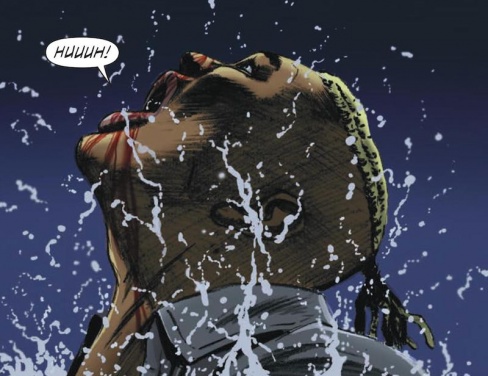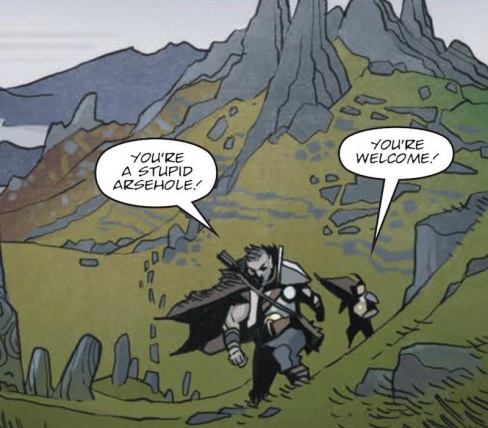
Welcome, Earthlets, to Multiver-City One, our “2000 AD” weekly review column! Every Wednesday we examine the latest offerings from Tharg and the droids over at Rebellion/2000 AD, the galaxy’s leading producers of Thrill-Power entertainment. Let’s get right to it!

THIS WEEK IN 2000AD

Judge Dredd: Simply Normal, Part 2
Credits: Kenneth Niemand (script), Steven Austin (art), Chris Blythe (colours), Annie Parkhouse (letters)
Noel Thorne: Daisy’s wife Pansy has been taken away for Simp Conversion Therapy, seemingly lawfully, so the Justice Department can’t intervene – who can Daisy turn to for help? The Radical Simp Underground!
The second part of “Simply Normal” unfortunately remains as dull and uninvolving as the first. Kenneth Niemand doesn’t do much to build on the premise and just inches the pieces forward from where they were at the end of “Part 1”: Daisy formally meets the Radical Simp Underground (RSU), Pansy’s still miserable and Dredd learns something new about the people behind Simply Normal.
Given that this episode is a mere six pages, it seems frivolous to use an entire page to underline (again) Pansy/Erma’s misery at being at Simply Normal, as well as four pages on the RSU beating up some random muggers, when neither do anything to advance the central plot. Spending this much time on these useless aspects makes reading this part feel like the filler it is that much more.
Steven Austin’s art is pretty decent. The comic is skilfully drawn – the Justice Department droid at the end looks great – though the character designs continue to be uninspired: the street punks in particular look exactly like you would imagine when you think of “street punks”. Arch-Fluke Ferdinand’s weapon box is also poorly designed – it doesn’t look at all like it could contain a mini-wrecking ball and the RSU’s headquarters isn’t very simp-y; it looks like any other underground club.
Chris Blythe’s colours in the opening panel are a pretty mix and give the comic a Blade Runner-esque atmosphere. Also, not that it needs it because the story is so basic, but the background colouring subtly hints at how you’re meant to feel about the characters: red background for the muggers to symbolise danger, light blue background for the simps to symbolise calm safety.
“Judge Dredd: Simply Normal, Part 2” isn’t bad visually but the narrative is sorely lacking in intrigue, characterisation or pacing to make it anywhere near interesting to read.

Stickleback: New Jerusalem, Part Seven
Credits: Ian Edginton (script), D’Israeli (art), Jim Cambell (letters)
Michael Mazzacane: We were promised a kaiju big battle and D’Israeli delivers one. They keep to the same basic structure of the previous strip, using large simple layouts that create big panels to capture the grandeur of large-scale monster fights. One of the things that these laysouts allow them to do is to play with scale. These big monsters only look big because of the scale involved, one of the ways that sense of scale is created is by juxtaposing them against the insignificant human audience – the least interesting part of just about any Godzilla movie. Throughout the strip Edginton and D’Istraeli return to Stickleback and Miss Scarlet or the Three Sisters both as a source of play by play but also to show how small they are amongst the wreckage.
The creative team obviously do not have the page budget to show off a duel on the scale of the one from “Lazarus” but the choreography and layouts are good enough that it evokes a similar feeling on 1/5th the scale. Fight scenes should tell a story and here the choreography, supported by Stickleback’s own commentary show how this isn’t a battle of monsters but monster and man, and that’s a problem. The page turn reveal of just how bad that land is lands wonderfully, with all the sudden impact of a knockout that you only see coming in retrospect. That blow also isn’t the end of the strip, there is still one more page that helps to transition the story into the next set of strips as it becomes clear the rest of the humans will have to deal with this Eldritch monster some other way.
Continued below
Hook-Jaw: Eight
Credits: Alex Worley (Writer), Leigh Gallagher (Art), Simon Bowland (Letters)
Jacob Cordas: And it’s about fucking time! I may have been gone but I stayed up to date on my reading. Don’t you worry, equally excited aquatic monster lovers. I was there during the reveals and the build up. I have been holding your hands as you try to crawl back on to the boat, something sinister swimming underneath. I was tense too. But now, my friends, now the monster has breached.
It does not disappoint. So far it’s been exclusively a person here, maybe two there – scattered corpses that let you know something shocking is coming. Gallagher’s art has hinted at the ugliness he is capable of but here he is finally allowed to cut loose.
The script properly sets up for this moment. Worley paces the ugliness with a hint of panic and chaos magick. Especially inspiring is the pay-off for the repeated use of social media over the course of the series. It serves as a perfect fake-out of false modesty before the splash page.
It overwhelms at first glance. Impossible viscera sprays in every direction. Limbs fall from the sky if they aren’t still hanging from the gaping maw of the monster. People flee till they are just small sketched outlines. Humanity doesn’t matter in the wreckage.
It’s horrifying. It’s fantastic. And it’s about fucking time!

Skip Tracer: Hyperballad Part Eight
Credits: James Peaty (script), Paul Marshall (art), Dylan Teague (colours) Simon Bowland (letters)
Ryan Pond: Eight chapters in we are finally seeing ‘Hyperballad’ wrap back around to the media res opening. The way that the first pages of the first chapter seamlessly meld into the middle of this chapter is masterful, and it goes on to set up a finale showdown with Van Hess in the next section.
As we come full circle, it is impressive to see how Peaty’s scripting has brought us back to where we started. The conditions aren’t much different from what we saw then, but the perspective radically alters our perception of why it is happening. There have been a lot of allies gained and lost to bring us here, but now we can finally see why Nolan and India were on the run way back then. The only thing that remains to be known now, is why Van Hess is doing this and what his endgame is going to be. The cliffhanger leaves those unanswered questions for next time, which seems fitting considering how much we learned in this issue.
Marshall is doing a great job on the artwork, with three distinct settings in this chapter that all look unique and separate from each other but all within the same style. It is also impressive how he was able to redraw the opening pages of the first story with some slight changes based on our learned perspective. I am impressed, as always, by the color work as it really highlights the technology used in this universe but also keeps the humans and alien creatures grounded in reality.
This was another fun chapter where we finally get the connection back to opening pages of ‘Hyperballad’ that started our adventure with Nolan and India. It seems the final trap has been laid, but Van Hess knew it was coming and seems to have his own counter trap for the duo.

Fiends of the Eastern Front: Constanta Part 7
Credits: Ian Edginton (script), Tiernen Trevallion (art), Annie Parkhouse (letters)
Greg Lincoln: The fates have their claws into both the Constanta and his adopted father figure Skade after the events of last chapter. In Part 7, Ian Edginton brings things full circle as the fates manipulate the path that Skade follows and brings the Constanta home to where he was born and nearly killed as an infant. It’s an interesting and unexpected twist in this story, as his older treacherous brother encounters the one gat got away. It’s only the amazing resemblance to his father that starts the older Constanta to suspect that this boy is his brother and that he may not have killed all of the bloodline yet. Who know what the events of this week will precipitate, but the ending of this chapter comes as a complete shock.
I have heaped praise on Trevallion with his stylistic approach to telling this tale, and this installment is no disappointment. The face of Varujan shows so much of who he is. It’s so clear that he is suspicious, then sure, then murderous, but in all those moments his madness plays through the art. Some of the faces he created in this chapter had a level of mirth to them that was refreshing to see with how grim things have been.






